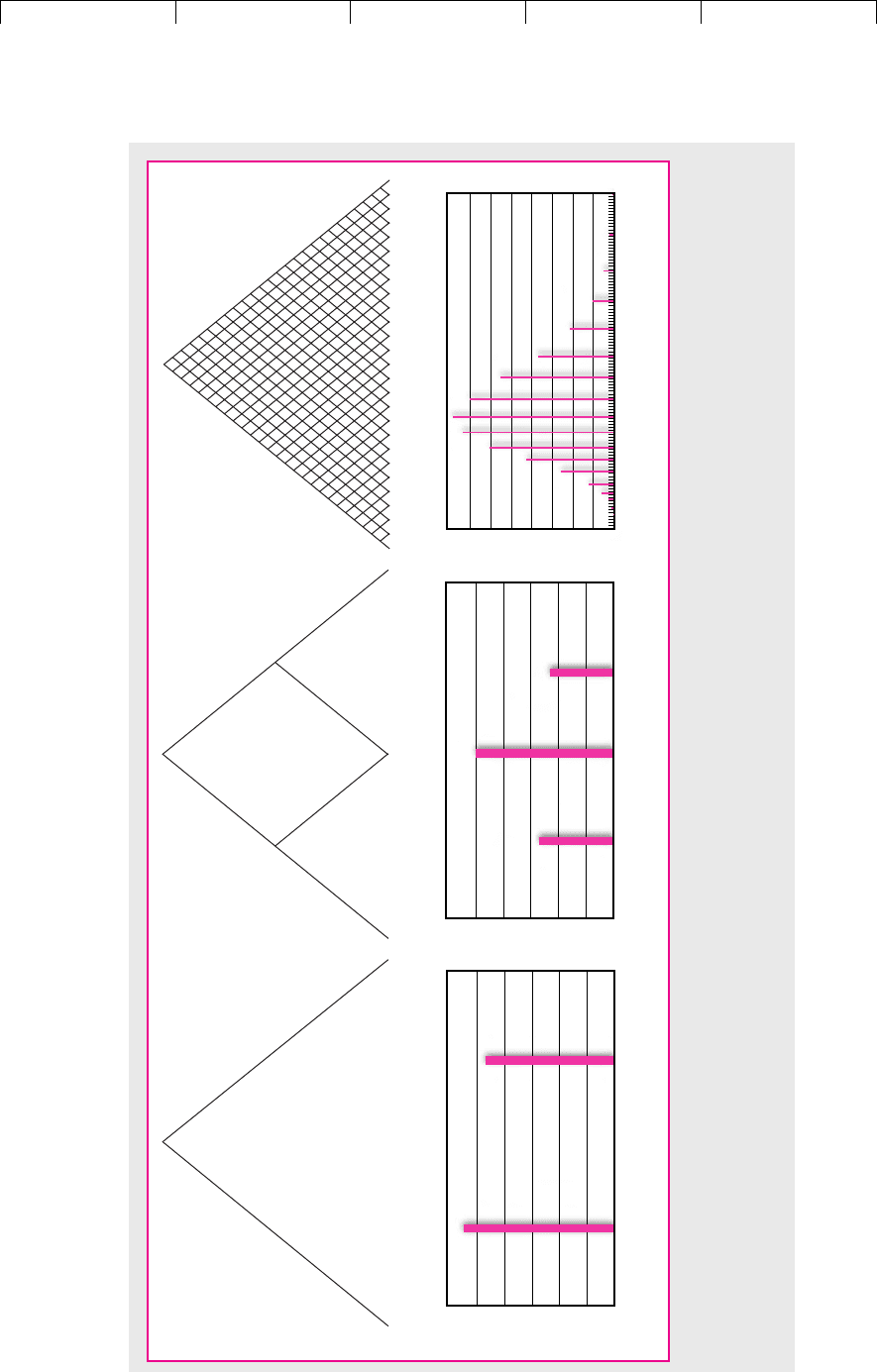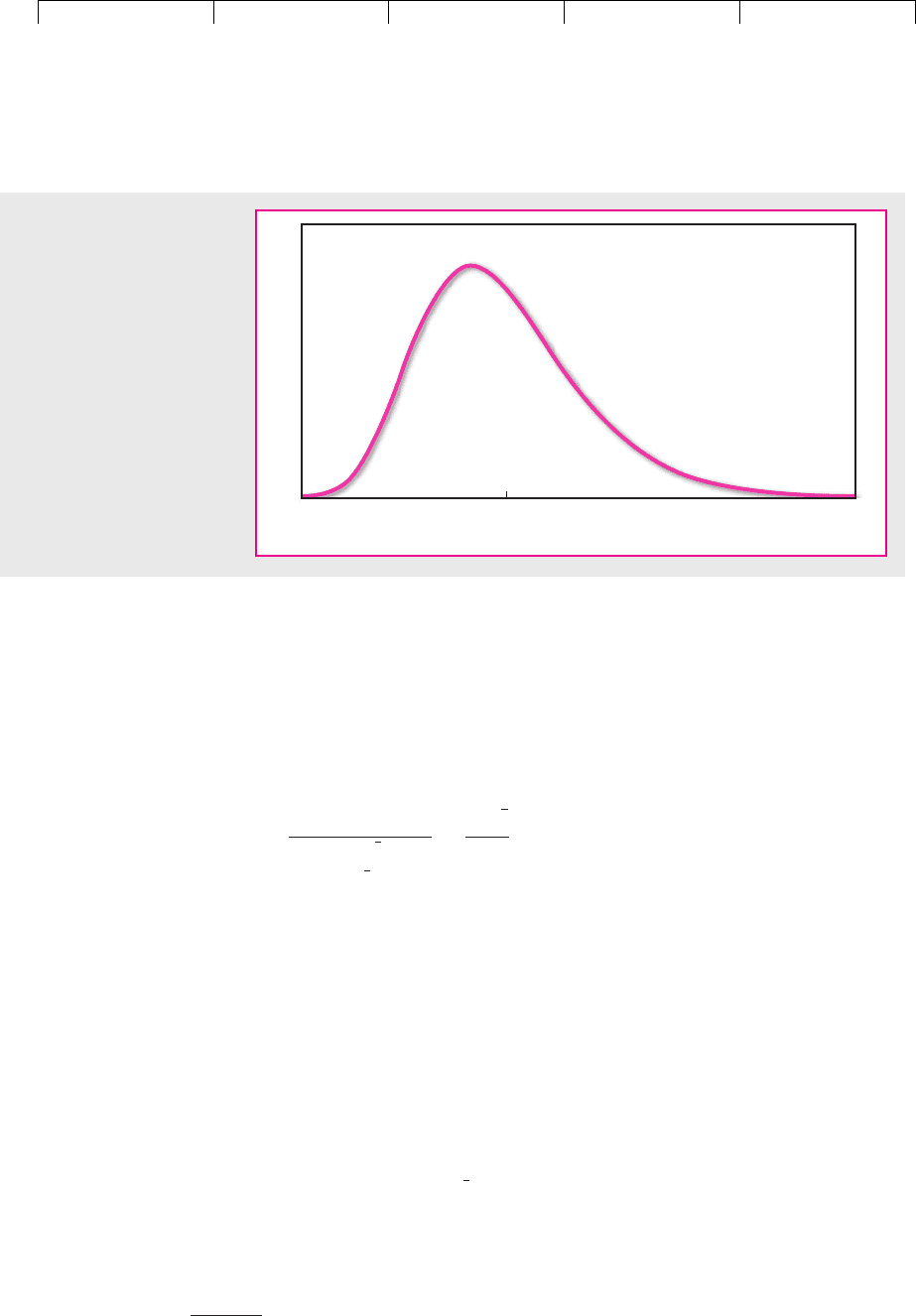Brealey, Myers. Principles of Corporate Finance. 7th edition
Подождите немного. Документ загружается.


Brealey−Meyers:
Principles of Corporate
Finance, Seventh Edition
VI. Options 21. Valuing Options
© The McGraw−Hill
Companies, 2003
Notice that the payoffs from the levered investment in the stock are identical to
the payoffs from the call option. Therefore, both investments must have the same
value:
Presto! You’ve valued a call option.
To value the AOL option, we borrowed money and bought stock in such a way
that we exactly replicated the payoff from a call option. This is called a replicating
portfolio. The number of shares needed to replicate one call is called the hedge ra-
tio or option delta. In our AOL example one call is replicated by a levered position
in .5714 shares. The option delta is, therefore, .5714.
How did we know that AOL’s call option was equivalent to a levered position
in .5714 shares? We used a simple formula that says
You have learned not only to value a simple option but also that you can repli-
cate an investment in the option by a levered investment in the underlying asset.
Thus, if you can’t buy or sell an option on an asset, you can create a homemade op-
tion by a replicating strategy—that is, you buy or sell delta shares and borrow or
lend the balance.
Risk-Neutral Valuation Notice why the AOL call option should sell for $8.32. If
the option price is higher than $8.32, you could make a certain profit by buying
.5714 shares of stock, selling a call option, and borrowing $23.11. Similarly, if the
option price is less than $8.32, you could make an equally certain profit by selling
.5714 shares, buying a call, and lending the balance. In either case there would be
a money machine.
4
If there’s a money machine, everyone scurries to take advantage of it. So when
we said that the option price had to be $8.32 (or there would be a money machine),
we did not have to know anything about investor attitudes to risk. The option price
cannot depend on whether investors detest risk or do not care a jot.
This suggests an alternative way to value the option. We can pretend that all in-
vestors are indifferent about risk, work out the expected future value of the option
in such a world, and discount it back at the risk-free interest rate to give the cur-
rent value. Let us check that this method gives the same answer.
If investors are indifferent to risk, the expected return on the stock must be equal
to the risk-free rate of interest:
We know that AOL stock can either rise by 33 percent to $73.33 or fall by 25 percent
to $41.25. We can, therefore, calculate the probability of a price rise in our hypo-
thetical risk-neutral world:
⫽ 2.0 percent
⫹ 311 ⫺ probability of rise2 ⫻ 1⫺2524
Expected return ⫽ 3probability of rise ⫻ 334
Expected return on AOL stock ⫽ 2.0% per six months
Option delta ⫽
spread of possible option prices
spread of possible share prices
⫽
18.33 ⫺ 0
73.33 ⫺ 41.25
⫽ .5714
⫽155 ⫻ .57142 ⫺ 23.11 ⫽ $8.32
Value of call ⫽ value of .5714 shares ⫺ $23.11
bank loan
CHAPTER 21 Valuing Options 593
4
Of course, you don’t get seriously rich by dealing in .5714 shares. But if you multiply each of our trans-
actions by a million, it begins to look like real money.

Brealey−Meyers:
Principles of Corporate
Finance, Seventh Edition
VI. Options 21. Valuing Options
© The McGraw−Hill
Companies, 2003
Therefore,
5
Notice that this is not the true probability that AOL stock will rise. Since investors
dislike risk, they will almost surely require a higher expected return than the risk-
free interest rate from AOL stock. Therefore the true probability is greater than .463.
We know that if the stock price rises, the call option will be worth $18.33; if it
falls, the call will be worth nothing. Therefore, if investors are risk-neutral, the ex-
pected value of the call option is
And the current value of the call is
Exactly the same answer that we got earlier!
We now have two ways to calculate the value of an option:
1. Find the combination of stock and loan that replicates an investment in the
option. Since the two strategies give identical payoffs in the future, they
must sell for the same price today.
2. Pretend that investors do not care about risk, so that the expected return on
the stock is equal to the interest rate. Calculate the expected future value of
the option in this hypothetical risk-neutral world and discount it at the risk-
free interest rate.
6
Valuing the AOL Put Option
Valuing the AOL call option may well have seemed like pulling a rabbit out of a
hat. To give you a second chance to watch how it is done, we will use the same
method to value another option—this time, the six-month AOL put option with a
$55 exercise price.
7
We continue to assume that the stock price will either rise to
$73.33 or fall to $41.25.
Expected future value
1 ⫹ interest rate
⫽
8.49
1.02
⫽ $8.32
⫽ $8.49
⫽ 1.463 ⫻ 18.332 ⫹ 1.537 ⫻ 02
3Probability of rise ⫻ 18.334 ⫹ 311 ⫺ probability of rise2 ⫻ 04
Probability of rise ⫽ .463, or 46.3%
594 PART VI Options
5
The general formula for calculating the risk-neutral probability of a rise in value is
In the case of AOL stock
6
In Chapter 9 we showed how you can value an investment either by discounting the expected cash
flows at a risk-adjusted discount rate or by adjusting the expected cash flows for risk and then dis-
counting these certainty-equivalent flows at the risk-free interest rate. We have just used this second
method to value the AOL option. The certainty-equivalent cash flows on the stock and option are the
cash flows that would be expected in a risk-neutral world.
7
When valuing American put options, you need to recognize the possibility that it will pay to exercise
early. We discuss this complication later in the chapter, but it is not relevant for valuing the AOL put
and we ignore it here.
p ⫽
.02 ⫺ 1⫺.252
.33 ⫺ 1⫺.252
⫽ .463
p ⫽
interest rate ⫺ downside change
upside change ⫺ downside change

Brealey−Meyers:
Principles of Corporate
Finance, Seventh Edition
VI. Options 21. Valuing Options
© The McGraw−Hill
Companies, 2003
If AOL’s stock price rises to $73.33, the option to sell for $55 will be worthless. If
the price falls to $41.25, the put option will be worth . Thus
the payoffs to the put are
$55 ⫺ 41.25 ⫽ $13.75
CHAPTER 21
Valuing Options 595
1 put option $13.75 $0
Stock Price ⫽ $73.33Stock Price ⫽ $41.25
We start by calculating the option delta using the formula that we presented above:
8
Notice that the delta of a put option is always negative; that is, you need to sell delta
shares of stock to replicate the put. In the case of the AOL put you can replicate the
option payoffs by selling .4286 AOL shares and lending $30.81. Since you have sold
the share short, you will need to lay out money at the end of six months to buy it
back, but you will have money coming in from the loan. Your net payoffs are ex-
actly the same as the payoffs you would get if you bought the put option:
Option delta ⫽
spread of possible option prices
spread of possible stock prices
⫽
0 ⫺ 13.75
73.33 ⫺ 41.25
⫽⫺.4286
8
The delta of a put option is always equal to the delta of a call option with the same exercise price mi-
nus one. In our example, delta of .
9
Reminder: This formula applies only when the two options have the same exercise price and exercise date.
put ⫽ .5714 ⫺ 1 ⫽⫺.4286
Sale of .4286 shares
Repayment of
Total payoff $13.75 $ 0
⫹31.43⫹31.43loan ⫹ interest
⫺$31.43⫺$17.68
Stock Price ⫽ $73.33Stock Price ⫽ $41.25
Since the two investments have the same payoffs, they must have the same value:
Valuing the Put Option by the Risk-Neutral Method Valuing the AOL put option
with the risk-neutral method is a cinch. We already know that the probability of a
rise in the stock price is .463. Therefore the expected value of the put option in a
risk-neutral world is
And therefore the current value of the put is
The Relationship between Call and Put Prices We pointed out earlier that for Eu-
ropean options there is a simple relationship between the value of the call and that
of the put:
9
Value of put ⫽ value of call ⫺ share price ⫹ present value of exercise price
Expected future value
1 ⫹ interest rate
⫽
7.38
1.02
⫽ $7.24
⫽ $7.38
⫽ 1.463 ⫻ 02 ⫹ 1.537 ⫻ 13.752
3Probability of rise ⫻ 04 ⫹ 311 ⫺ probability of rise2 ⫻ 13.754
⫽ ⫺ 1.4286 ⫻ 552 ⫹ 30.81 ⫽ $7.24
Value of put ⫽⫺.4286
shares ⫹ $30.81 bank loan

Brealey−Meyers:
Principles of Corporate
Finance, Seventh Edition
VI. Options 21. Valuing Options
© The McGraw−Hill
Companies, 2003
Since we had already calculated the value of the AOL call, we could also have used
this relationship to find the value of the put:
Everything checks.
Value of put ⫽ 8.32 ⫺ 55 ⫹
55
1.02
⫽ $7.24
596 PART VI Options
21.2 THE BINOMIAL METHOD FOR VALUING OPTIONS
The essential trick in pricing any option is to set up a package of investments in the
stock and the loan that will exactly replicate the payoffs from the option. If we can
price the stock and the loan, then we can also price the option. Equivalently, we can
pretend that investors are risk-neutral, calculate the expected payoff on the option
in this fictitious risk-neutral world, and discount by the rate of interest to find the
option’s present value.
These concepts are completely general, but there are several ways to find the
replicating package of investments. The example in the last section used a sim-
plified version of what is known as the binomial method. The method starts by
reducing the possible changes in next period’s stock price to two, an “up” move
and a “down” move. This simplification is OK if the time period is very short,
so that a large number of small moves is accumulated over the life of the option.
But it was fanciful to assume just two possible prices for AOL stock at the end
of six months.
We could make the AOL problem a trifle more realistic by assuming that there
are two possible price changes in each three-month period. This would give a
wider variety of six-month prices. And there is no reason to stop at three-month
periods. We could go on to take shorter and shorter intervals, with each interval
showing two possible changes in AOL’s stock price and giving an even wider se-
lection of six-month prices.
This is illustrated in Figure 21.1. The two left-hand diagrams show our start-
ing assumption: just two possible prices at the end of six months. Moving to the
right, you can see what happens when there are two possible price changes
every three months. This gives three possible stock prices when the option ma-
tures. In Figure 21.1(c) we have gone on to divide the six-month period into 26
weekly periods, in each of which the price can make one of two small moves.
The distribution of prices at the end of six months is now looking much more
realistic.
We could continue in this way to chop the period into shorter and shorter inter-
vals, until eventually we would reach a situation in which the stock price is chang-
ing continuously and there is a continuum of possible future stock prices.
Example: The Two-Stage Binomial Method
Dividing the period into shorter intervals doesn’t alter the basic method for valu-
ing a call option. We can still replicate the call by a levered investment in the stock,
but we need to adjust the degree of leverage at each stage. We will demonstrate
first with our simple two-stage case in Figure 21.1 (b). Then we will work up to the
situation where the stock price is changing continuously.

Brealey−Meyers:
Principles of Corporate
Finance, Seventh Edition
VI. Options 21. Valuing Options
© The McGraw−Hill
Companies, 2003
597
–25 +33
60
0
10
20
40
30
50
Probability %
Percent price changes
(a) Percent price changes
–25 0 +33
54
46
–33 0 +50
+22.6⫺18.4
60
0
10
20
40
30
50
Probability %
Percent price changes
(b) Percent price changes
–33 0 +50
27
50
23
–77 –74 –71 –68 –64 –59 –55 –49 –43 –36 –29 –20 –11 4 12 25 40 57 76 97 120 147 176 209 246 287 334
0
–20–11 4 2512 40 57 76 97 120 147
16
2
8
12
10
14
4
6
Probability %
Percent price changes
(c) Percent price changes
FIGURE 21.1
This figure shows the possible six-month price changes for AOL stock assuming that the stock makes a single up or down move each six months [Fig. 21.1(a)], each
three months [Fig. 21.1(b)], or each week [Fig. 21.1(c)]. Beneath each tree we show a histogram of the possible six-month price changes, assuming investors are risk-
neutral.

Brealey−Meyers:
Principles of Corporate
Finance, Seventh Edition
VI. Options 21. Valuing Options
© The McGraw−Hill
Companies, 2003
Figure 21.2 is taken from Figure 21.1 (b) and shows the possible prices of AOL
stock, assuming that in each three-month period the price will either rise by 22.6
percent or fall by 18.4 percent. We show in parentheses the possible values at
maturity of a six-month call option with an exercise price of $55. For example, if
AOL’s stock price turns out to be $36.62 in month 6, the call option will be
worthless; at the other extreme, if the stock value is $82.67, the call will be worth
. We haven’t worked out yet what the option will be worth
before maturity, so we just put question marks there for now.
Option Value in Month 3 To find the value of AOL’s option today, we start by
working out its possible values in month 3 and then work back to the present. Sup-
pose that at the end of three months the stock price is $67.43. In this case investors
know that, when the option finally matures in month 6, the stock price will be ei-
ther $55 or $82.67, and the corresponding option price will be $0 or $27.67. We can
therefore use our simple formula to find how many shares we need to buy in
month 3 to replicate the option:
Now we can construct a leveraged position in delta shares that would give iden-
tical payoffs to the option:
Option delta ⫽
spread of possible option prices
spread of possible stock prices
⫽
27.67 ⫺ 0
82.67 ⫺ 55
⫽ 1.0
$82.67 ⫺ $55 ⫽ $27.67
598 PART VI Options
Month 6 Stock Month 6 Stock
Buy 1.0 shares $55 $82.67
Borrow PV(55) ⫺55 ⫺55
Total payoff $ 0 $27.67
Price ⫽ $82.67Price ⫽ $55
$55.00
(?)
Now
$82.67
($27.67)
$36.62
($0)
$55.00
($0)
Month 6
Month 3
$67.43
(?)
$44.88
(?)
FIGURE 21.2
Present and possible future prices of AOL stock assuming
that in each three-month period the price will either rise
by 22.6% or fall by 18.4%. Figures in parentheses show
the corresponding values of a six-month call option with
an exercise price of $55.
Since this portfolio provides identical payoffs to the option, we know that the value
of the option in month 3 must be equal to the price of 1 share less the $55 loan dis-
counted for 3 months at 4 percent per year, about 1 percent for 3 months:
Therefore, if the share price rises in the first three months, the option will be worth
$12.97. But what if the share price falls to $44.88? In that case the most that you can
Value of call in month 3 ⫽ $67.43 ⫺ $55/1.01 ⫽ $12.97

Brealey−Meyers:
Principles of Corporate
Finance, Seventh Edition
VI. Options 21. Valuing Options
© The McGraw−Hill
Companies, 2003
CHAPTER 21 Valuing Options 599
hope for is that the share price will recover to $55. Therefore the option is bound to
be worthless when it matures and must be worthless at month 3.
Option Value Today We can now get rid of two of the question marks in Figure
21.2. Figure 21.3 shows that if the stock price in month 3 is $67.43, the option value
is $12.97 and, if the stock price is $44.88, the option value is zero. It only remains to
work back to the option value today.
We again begin by calculating the option delta:
We can now find the leveraged position in delta shares that would give identical
payoffs to the option:
Option delta ⫽
spread of possible option prices
spread of possible stock prices
⫽
12.97 ⫺ 0
67.43 ⫺ 44.88
⫽ .575
$55.00
(?)
Now
$82.67
($27.67)
$36.62
($0)
$55.00
($0)
Month 6
Month 3
$67.43
($12.97)
$44.88
($0)
FIGURE 21.3
Present and possible future prices of AOL stock. Figures
in parentheses show the corresponding values of a six-
month call option with an exercise price of $55.
Month 3 Stock Month 3 Stock
Buy .575 shares $25.81 $38.78
Borrow PV(25.81) ⫺25.81 ⫺25.81
Total payoff $ 0 $12.97
Price ⫽ $67.43Price ⫽ $44.88
The value of the AOL option today is equal to the value of this leveraged position:
The General Binomial Method
Moving to two steps when valuing the AOL call probably added extra realism. But
there is no reason to stop there. We could go on, as in Figure 21.1, to chop the pe-
riod into smaller and smaller intervals. We could still use the binomial method to
work back from the final date to the present. Of course, it would be tedious to do
the calculations by hand, but simple to do so with a computer.
Since a stock can usually take on an almost limitless number of future values, the
binomial method gives a more realistic and accurate measure of the option’s value if
⫽ .575 ⫻ $55 ⫺
$25.81
1.01
⫽ $6.07
PV option ⫽ PV1.575 shares2 ⫺ PV1$25.812

Brealey−Meyers:
Principles of Corporate
Finance, Seventh Edition
VI. Options 21. Valuing Options
© The McGraw−Hill
Companies, 2003
600 PART VI Options
we work with a large number of subperiods. But that raises an important question.
How do we pick sensible figures for the up and down changes in value? For exam-
ple, why did we pick figures of percent and percent when we revalued
AOL’s option with two subperiods? Fortunately, there is a neat little formula that re-
lates the up and down changes to the standard deviation of stock returns:
where
for natural
deviation of (continuously compounded) stock returns
as fraction of a year
When we said that AOL’s stock could either rise by 33.3 percent or fall by 25 per-
cent over six months , our figures were consistent with a figure of 40.69 per-
cent for the standard deviation of annual returns:
To work out the equivalent upside and downside changes when we divide the pe-
riod into two three-month intervals (h ⫽ .25) , we use the same formula:
The center columns in Table 21.1 show the equivalent up and down moves in the
value of the firm if we chop the period into monthly or weekly periods, and the fi-
nal column shows the effect on the estimated option value. (We will explain the
Black–Scholes value shortly.)
The Binomial Method and Decision Trees
Calculating option values by the binomial method is basically a process of solving
decision trees. You start at some future date and work back through the tree to the
present. Eventually the possible cash flows generated by future events and actions
are folded back to a present value.
Is the binomial method merely another application of decision trees, a tool of
analysis that you learned about in Chapter 10? The answer is no, for at least two
1 ⫹ downside change ⫽ d ⫽ 1/u ⫽ 1/1.226 ⫽ .816
1 ⫹ upside change 13-month interval2 ⫽ u ⫽ e
.40692.25
⫽ 1.226
1 ⫹ downside change ⫽ d ⫽ 1/u ⫽ 1/1.333 ⫽ .75
1 ⫹ upside change 16-month interval2 ⫽ u ⫽ e
.40692.5
⫽ 1.333
1h ⫽ .52
h ⫽ interval
⫽ standard
logarithms ⫽ 2.718e ⫽ base
1 ⫹ downside change ⫽ d ⫽ 1/u
1 ⫹ upside change ⫽ u ⫽ e
2h
⫺18.4⫹22.6
Intervals in
Change per Interval (%)
Estimated Option
a Year (1/h) Upside Downside Value
2 $8.32
4 6.07
12 6.65
52 6.75
Black–Scholes value ⫽ $6.78
⫺5.5⫹ 5.8
⫺11.1⫹12.4
⫺18.4⫹22.6
⫺25.0⫹33.3
TABLE 21.1
As the number of intervals is
increased, you must adjust the range
of possible changes in the value of the
asset to keep the same standard
deviation. But you will get increasingly
close to the Black–Scholes value of the
AOL call option.
Note: The standard deviation is . ⫽ .4069

Brealey−Meyers:
Principles of Corporate
Finance, Seventh Edition
VI. Options 21. Valuing Options
© The McGraw−Hill
Companies, 2003
reasons. First, option pricing theory is absolutely essential for discounting
within decision trees. Standard discounting doesn’t work within decision trees
for the same reason that it doesn’t work for puts and calls. As we pointed out in
Section 21.1, there is no single, constant discount rate for options because the
risk of the option changes as time and the price of the underlying asset change.
There is no single discount rate inside a decision tree, because if the tree contains
meaningful future decisions, it also contains options. The market value of the fu-
ture cash flows described by the decision tree has to be calculated by option
pricing methods.
Second, option theory gives a simple, powerful framework for describing
complex decision trees. For example, suppose that you have the option to post-
pone an investment for many years. The complete decision tree would overflow
the largest classroom chalkboard. But now that you know about options, the op-
portunity to postpone investment might be summarized as “an American call on
a perpetuity with a constant dividend yield.” Of course, not all real problems
have such easy option analogues, but we can often approximate complex deci-
sion trees by some simple package of assets and options. A custom decision tree
may get closer to reality, but the time and expense may not be worth it. Most men
buy their suits off the rack even though a custom-made suit from Saville Row
would fit better and look nicer.
CHAPTER 21
Valuing Options 601
21.3 THE BLACK–SCHOLES FORMULA
Look back at Figure 21.1, which showed what happens to the distribution of pos-
sible AOL stock price changes as we divide the option’s life into a larger and larger
number of increasingly small subperiods. You can see that the distribution of price
changes becomes increasingly smooth.
If we continued to chop up the option’s life in this way, we would eventually
reach the situation shown in Figure 21.4, where there is a continuum of possible
stock price changes at maturity. Figure 21.4 is an example of a lognormal distribu-
tion. The lognormal distribution is often used to summarize the probability of dif-
ferent stock price changes.
10
It has a number of good commonsense features. For
example, it recognizes the fact that the stock price can never fall by more than 100
percent, but that there is some, perhaps small, chance that it could rise by much
more than 100 percent.
Subdividing the option life into indefinitely small slices does not affect the
principle of option valuation. We could still replicate the call option by a levered
investment in the stock, but we would need to adjust the degree of leverage con-
tinuously as time went by. Calculating option value when there is an infinite
number of subperiods may sound a hopeless task. Fortunately, Black and Scholes
derived a formula that does the trick. It is an unpleasant-looking formula, but on
10
When we first looked at the distribution of stock price changes in Chapter 8, we assumed that these
changes were normally distributed. We pointed out at the time that this is an acceptable approximation
for very short intervals, but the distribution of changes over longer intervals is better approximated by
the lognormal.

Brealey−Meyers:
Principles of Corporate
Finance, Seventh Edition
VI. Options 21. Valuing Options
© The McGraw−Hill
Companies, 2003
602 PART VI Options
closer acquaintance you will find it exceptionally elegant and useful. The for-
mula is
↑↑ ↑
3N(d
1
) ⫻ P4 ⫺ 3N(d
2
) ⫻ PV(EX)4
where
normal probability density function
11
price of option; PV(EX) is calculated by discounting at the
risk-free interest rate
of periods to exercise date
of stock now
deviation per period of (continuously compounded) rate of
return on stock
Notice that the value of the call in the Black–Scholes formula has the same proper-
ties that we identified earlier. It increases with the level of the stock price P and de-
creases with the present value of the exercise price PV(EX), which in turn depends
on the interest rate and time to maturity. It also increases with the time to maturity
and the stock’s variability .
To derive their formula Black and Scholes assumed that there is a continuum
of stock prices, and therefore to replicate an option investors must continu-
ously adjust their holding in the stock. Of course this is not literally possible,
12t
2
⫽ standard
P ⫽ price
t ⫽ number
r
f
EX ⫽ exercise
N1d2 ⫽ cumulative
d
2
⫽ d
1
⫺ 2t
d
1
⫽
log 3P/PV1EX24
2t
⫹
2t
2
Value of call option ⫽ 3delta ⫻ share price4 ⫺ 3bank loan4
Probability
Percent price changes
–70 0 +130
FIGURE 21.4
As the option’s life is divided
into more and more sub-
periods, the distribution of
possible stock price changes
approaches a lognormal
distribution.
11
That is, N(d) is the probability that a normally distributed random variable
˜
x will be less than or equal
to d. in the Black–Scholes formula is the option delta. Thus the formula tells us that the value of
a call is equal to an investment of in the common stock less borrowing of .N1d
2
2 ⫻ PV1EX2N1d
1
2
N1d
1
2
